|
Me Sahyadri |
|
January 2017 |
|
Volume 4, number 1, #43 |
|
Keep Audio Low |
|
|
Please use minimum 1280 pixel horizontal screen resolution for viewing. Please be patient while all the images in webpage are loaded. Please do not use the images for any commercial use without permission. Text in Marathi and English is not exact translation. Please give sufficient time to allow the photographs to load. Special thanks to all those who helped me during the compilation and for the help and guidance during the activity. |
|
|
|
|
देशाची आर्थिक प्रगती व्हावी असे सर्व नागरिकांना वाटणे सहाजिक आहे. अर्थकारणामुळे मिळणारा रोजगार, समृद्धी यासाठी सर्वांनाच आर्थिक प्रगती हवी हवीशी वाटते. आर्थिक प्रगती होताना, त्याचा दिर्घकाळात समाजावर, निसर्गावर, वातावरणावर दुष्परिणाम होणार नाही याची काळजी घेणे महत्वाचे आहे. मनुष्याच्या भावी पिढ्यांना पाणी, शुद्ध हवा, योग्य वातावरण मिळत रहावे अशी भावना मनात रुजणे महत्वाचे आहे. वाढत्या आर्थिक प्रगतीमुळे नैसर्गिक संपदेवर ताण येतो. प्रगतीसाठी प्रदुषण होते. जंगले, माळराने, व इतर अधिवास नष्ट होतात. वसुंधरेवर रहाणाऱ्या इतर जीवांचा मात्र मनुष्य फारसा विचार करत नाही. आर्थिक प्रगती करताना, मनुष्य निसर्गाची हानी करत आहे. मुळताच माणसाला निसर्गाचे महत्व समजणे हे सध्याच्या आपल्या प्रगत जीवनशैली मुळे अवघड झाले आहे. आर्थिक प्रगती, समाजाची प्रगती व निसर्ग संपदेची निगा, यांचा समतोल राखणे काळाची गरज आहे.
सह्याद्री (पश्चिम घाट) हा एक नैसर्गिक संपदेचा, वैविध्यतेचा, भौगोलिक व ऐतिहासिक ठेवा आहे. वाढत्या मानवी अतिक्रमणाचा, सह्याद्रीच्या विविध घटकांवर होणारा दुष्परिणाम भविष्यात आपल्यालाच धोका निर्माण करेल, यात शंका नाही. शुद्ध पाणी, हवा व उर्जा, भावी पिढीला मिळण्यासाठी, नंद्यांचे उगम असलेला सह्याद्री व त्याभागातील जंगले टिकवणे महत्वाचे आहे. सह्याद्रीच्या महत्वाच्या घटकांचे महत्व छायाचित्रांद्वारे प्रकट करण्याचा मी येथे प्रयत्न केला आहे. येथील पक्षी, प्राणी, वनस्पती, अधिवास, किल्ले व लेणी अशा विविध विषयांबद्दल आपण समजुन घेऊ.
|
|
As the economic development has taken the center stage, the balance between the environmental sustenance and socio economic development will be under the scanner. As most experts with balanced views have proclaimed, Indian wildlife and ecological system sustenance will be under threat, unless precautions are taken with the help of appropriate research and long term national interests. As we encounter the economic development, many habitats which indirectly or directly help sustainable development will be damaged. The awareness to gauge the success by sustainable development and not by year to year growth is a distant dream any environmentalist will assume in current scenario.
Western ghats, or Sahyadri as we all call it as, is a treasure trove of spectacular landscapes, biodiversity, flora, fauna, some amazing geological wonders and man made monuments. With the increasing pressure from human encroachment, all these elements are under stress and in turn are under depletion. Western ghats should be left untouched by human beings, to protect their future generations from getting short of resources, such as water, energy and clean air. The important elements of western ghats, which need protection are highlighted in the new version of Photo journal, Me Sahyadri Magazine. The current issue has few of the forest birds from the north Western Ghats.
|
|
|
| |
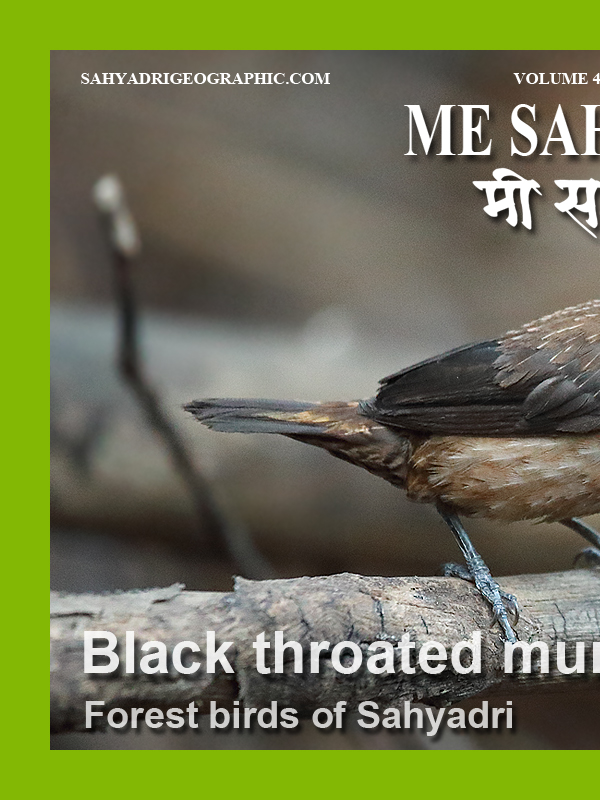 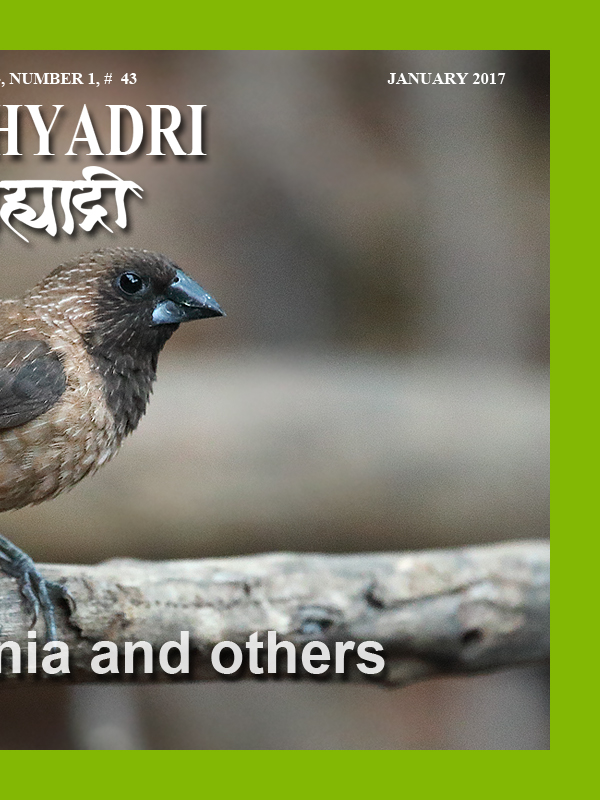
|
| |
| Me Sahyadri – January 2017
|
| |
|
|
| |
  |
| The banner has been published here to improve the awareness of the trekkers and tourists visiting the various mountain forts, mountains in north western ghats. Please avoid accidents, by following good outdoor ethics such as no swimming in cisterns at mountain forts, no rock climbing without proper technical equipment and expertise. Please do not adventure, trek with any group or individually without understanding the risks associated. The frequency of the solo trekker fatalities have increased recently. Please strictly avoid solo treks. Please also avoid treks to mountains in large commercial groups, as it leads to damage to biodiversity of these high elevation ecological islands. Please respect the wildlife and biodiversity of the region. This has become more important as the ever increasing human interference is leading to severe damage to fragile ecosystems. Please be aware of the wildlife and biodiversity of the mountains before visiting these mountains. Please follow outdoor ethics. Follow ASI and Forest department rules. The concept of use of symbols for outdoor ethics was conceived and designed by "Sahyadri Trekker Bloggers Group". |
| |
|
|
| |
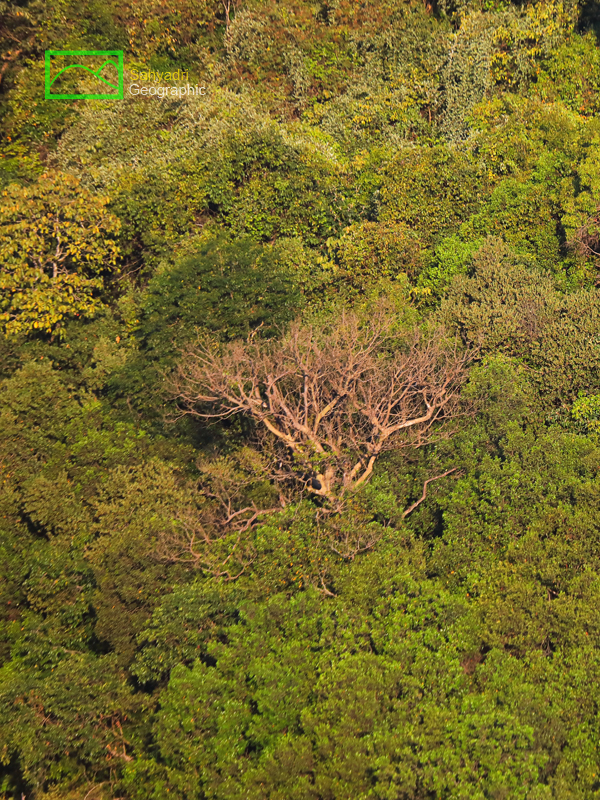 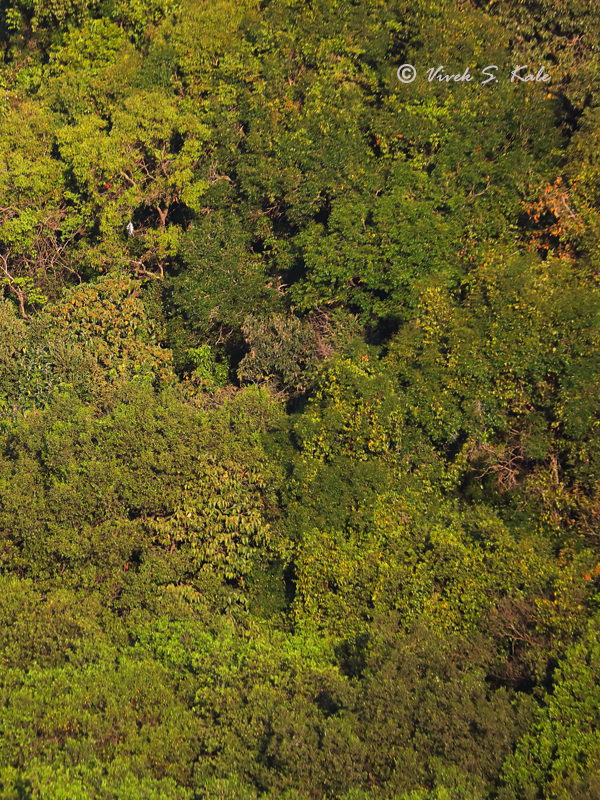 |
| 1. Evergreen forest, Pune district, Maharashtra, Western ghats, India |
| |
|
|
उत्तर सह्याद्री चे चार विभागांमध्ये वर्गीकरण करता येइल. पहिल्या भागात, पश्चिमेकडे कोकणात लहान टेकड़्यच्या आजुबाजुस असलेले जंगल मुख्यत: सदाहरित आणी पानगळीचे आहे. दुसऱ्या भागात घाटमाथ्यावर, सदाहरित जंगल आहे. तिसऱ्या भागात घाटावर पण घाट्माथ्यापासुन देशावरच्या आतल्या भागात पानगळीचे जंगल आहे. चौथ्या देशावरच्या पर्जन्यछायेच्या भागात, कोरडे खडकाळ माळरान वने आहेत. या चित्रनिबंधात आपण सदाहरित जंगलातील काही पक्ष्यांचा आढावा घेत आहोत. घाटमाथ्यावरच्या दक्खन च्या पठारावरचे जंगल सदाहरित आहे आणी येथे जैवविविधता विपुल आहे. सदाहरित जंगलाच्या चिंचोळ्या पट्टीत पक्षी जीवन समॄद्ध आहे. वर नमुद केलेल्या भागांत अंदाजे ४०० + पक्ष्यांच्या जाती आढळतात. सदाहरित व पानगळीच्या जंगल भागात अंदाजे २००+ पक्ष्यांच्या जाती आढळतात. यातील २० जाती अंतर्जन्य आहेत. अंतर्जन्य म्हणजे, अश्या जाती ज्या या भागाव्यतिरिक्त इतरत्र आढळत नाहीत. यातील काही पक्षी सह्याद्रिच्या उत्तर भागात (गुजरात, महाराष्ट्र) येथे आढळतात.
|
|
North western ghats can be divided in to four zones. The western most zone is the Konkan region just below the western ghat ridge. The region has mix of evergreen and semidecidous forests. The second region is along the ridge at higher elevation and at the edge of Deccan plateau, called as ghatmatha, which has evergreen forest. The third region is on and around the hills on Deccan platau east of the ridge. This region mainly has semidecidoius forest. The fourth region is rain shadow region hills further east which has dry and arid habitat with grasslands. In this photoessay some of the birds from the first three forest regions are described. The evergreen forests atop the edge on Deccan plateau are rich in its biodiversity. The narrow band of this habitat all along the Western Ghats has some amazing forest birds. About 400+ species are seen in and around the four zones described above. The forest birds in particular are restricted to very narrow band of the region. Out of about 200+ birds seen in evergreen and semidecidous forests, in Western Ghats, there are about 20 endemic species. In northen section of Western Ghats some of these endemic species can be seen.
|
|
|
| |
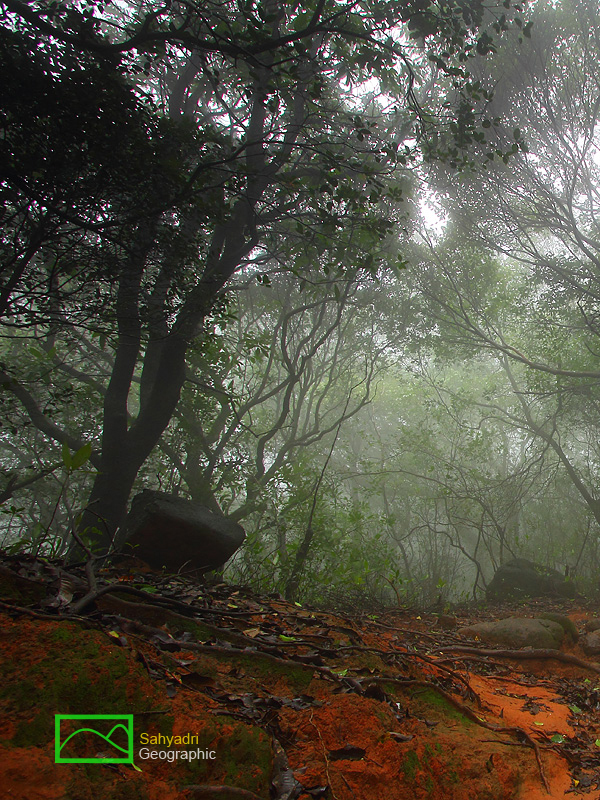 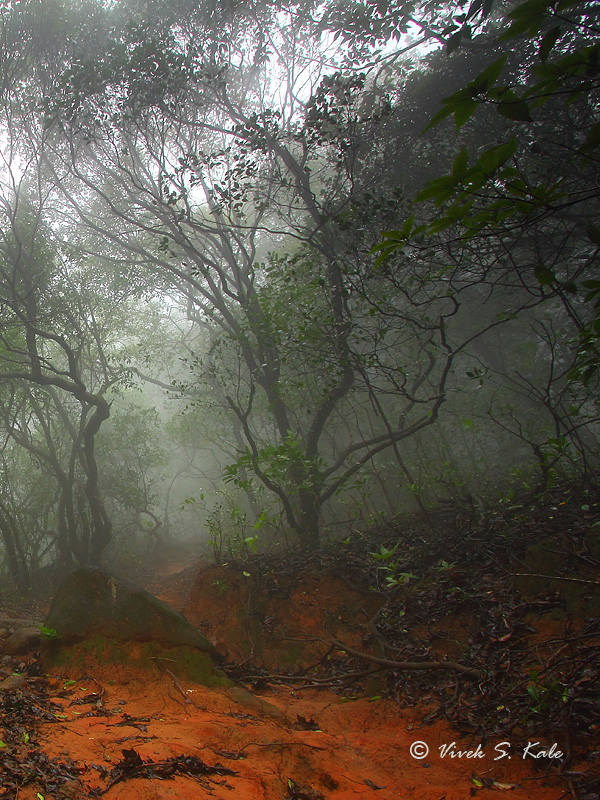 |
| 2. Evergreen forest, Pune district, Maharashtra, Western ghats, India |
| |
|
|
सह्याद्रीच्या जंगलात आढळणाऱ्या पक्ष्यांचे वर्गिकरण विविध पद्धतीने करता येइल. स्थानिक, जवळपास स्थलांतर करणारे, दुर पल्याचे स्थलांतर करणारे असे एक वर्गिकरण करता येते. सह्याद्रीच्या जंगलात आढळणारे काही पक्षी हिमालयाच्या जंगलातुन स्थलांतर करुन येथे येतात. स्थानिक पक्षी ऋतुमानाप्रमाणे जवळपास स्थलांतर करतात अथवा एकाच ठिकाणी थांबतात. यात काही पक्षी अंतर्जन्य आहेत. सह्याद्रीतले अंतर्जन्य पक्षी म्हणजे जे सह्याद्रीच्या बाहेर आढळत नाहीत असे पक्षी होत. सह्याद्रीच्या उत्तर भागात (महाराष्ट्र, गुजरात) येथे पर्जन्यमान कमी आहे. दक्षिणेकडे (गोवा, कर्नाटक, तमिळनाडु, केरळ) येथे पर्जन्यमान जास्त आहे. दक्षिणेकडील जंगले पर्जन्य वने आहेत. दक्षिण अमेरिका, दक्षिण पूर्व आशिया येथील पर्जन्यावनात आढळणाऱ्या पक्ष्यांच्या जैवविविधतेच्या तुलनेने आपल्या सह्याद्रीत आढ्ळणाऱ्या पक्ष्यांच्या वैविध्यतेत तुट असली तरी सह्याद्रीच्या अंतर्जन्य पक्ष्यांच्या जातींमुळे येथील पक्ष्यांचे व त्यांच्या अधिवासाचे महत्व कमी लेखता येणार नाही.
|
|
The forest birds in western ghats can be classified as resident, local migrants and migratory. Many forest birds migrate from forests around Himalaya to forests in western ghats and rest of India. The birds can also be classified as endemic and non endemic. The endemic birds are the ones which can be found only in region, western ghats in this case. The non endemic birds are the ones which are the ones which are seen not exclusively only in western ghats. Though the variety of birds seen in western ghats is not as high as in tropical forests in south America and elsewhere in south east Asia, western ghats has wide range of forest bird species.
|
|
|
| |
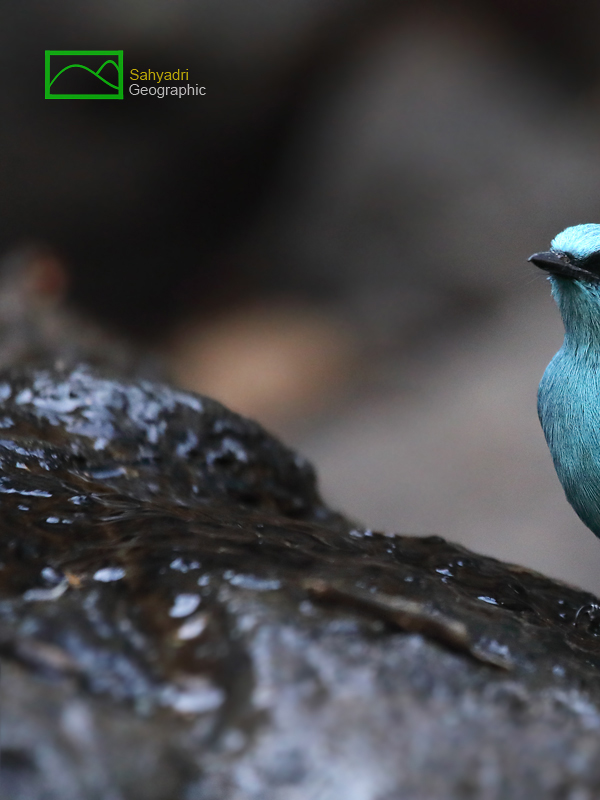  |
| 3. Verditer flycatcher, evergreen forest, Maharashtra, Western ghats, India |
| |
|
|
व्हरडाइटर फ्लायकॅचर हा सुंदर पक्षी, सह्याद्रीच्या सदाहरित आणी पानगळीच्या जंगलात हिवाळ्यात आढळतो. या पक्ष्याला मराठीत निलिमा असे म्हणतात. याचे शास्त्रीय नाव युमायस थालसिनस असे आहे. आय. यु. सि. एन, संस्थेच्या वर्गिकरणाप्रमाणे हा पक्षी "लिस्ट कन्सर्न्ड" आहे. हा पक्षी उन्हाळ्यात व पावसाळ्यात हिमालयाच्या जंगलात आढळतो. तेथे त्याचा विणीचा हंगाम पूर्ण करुन तो हिवाळ्यात दक्षिणेकडे भारताच्या सह्याद्रीत व इतर जंगलात स्थलांतर करतो.
व्हरडाइटर फ्लायकॅचर चे नाव व्हरडाइटर नावाच्या रासायनिक संयुगावरुन पडले आहे. कॉपर सल्फेट च्या हिरवट निळसर रंगाच्या या पक्ष्याची चोच, डोळ्यापुढचा भाग, पाय काळ्या रंगाचे असतात. इतर अंग हिरवट निळसर रंगाचे असते. जंगलात लहान किटक हे याचे मुख्य खाद्य आहे.
|
|
The verditer flycatcher is one of the most enigmatic bird in western ghats. The scientifc name of this bird is Eumyias thalassinus. Though the bird is “least concern” bird as per IUCN categorisation, it is important migratory forest bird of our region. The bird is known for its color, verditer blue. Verditer blue is a colour of chemical compound copper sulphate. The word verditer origins to the mineral. The portion between lore to base of bill is black. The eye iris is hazel brown. The bill, legs, feet and claw are black colored. The size of the bird is about 150 mm. The female is similar to male bird, with dull greyish tint. Lores are dull brown. In summer this flycatcher is found between 1300 to 2700 meter in the Himalaya and higher. It breeds mainly in Himalaya with some exceptions of south India.In winter it descends from Himalaya to the plains and spreads all over North and Central India. In winter it is seen around in semideciduous, evergreen forest. The bird is also seen in south east asia.
|
|
|
| |
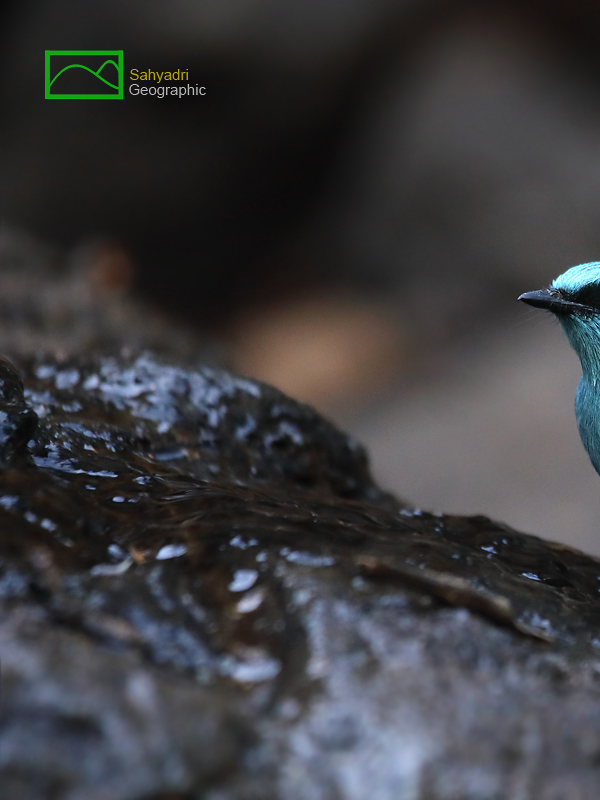 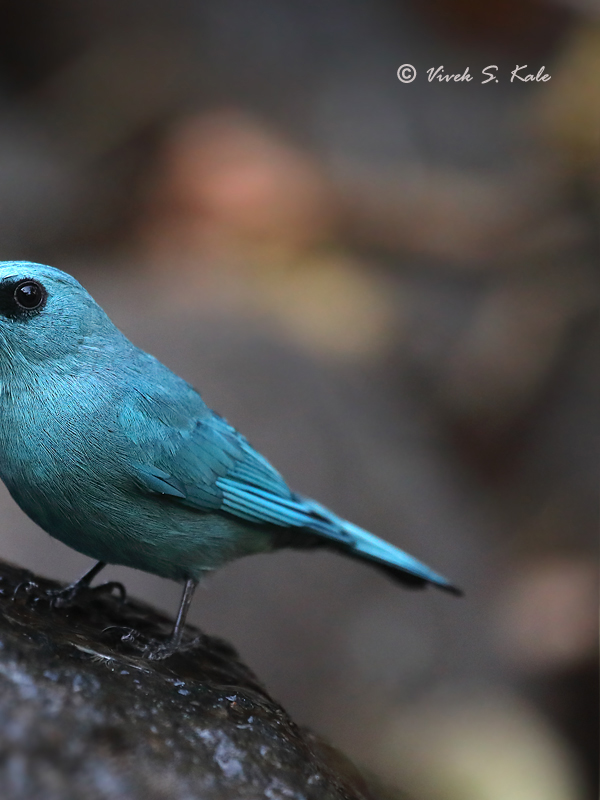  |
| 4. Verditer flycatcher, evergreen forest, Maharashtra, Western ghats, India |
| |
|
|
| |
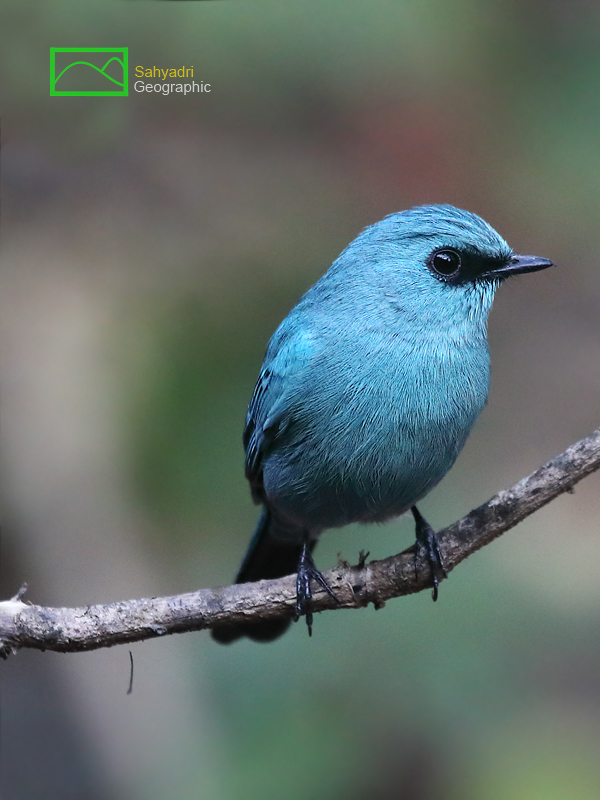 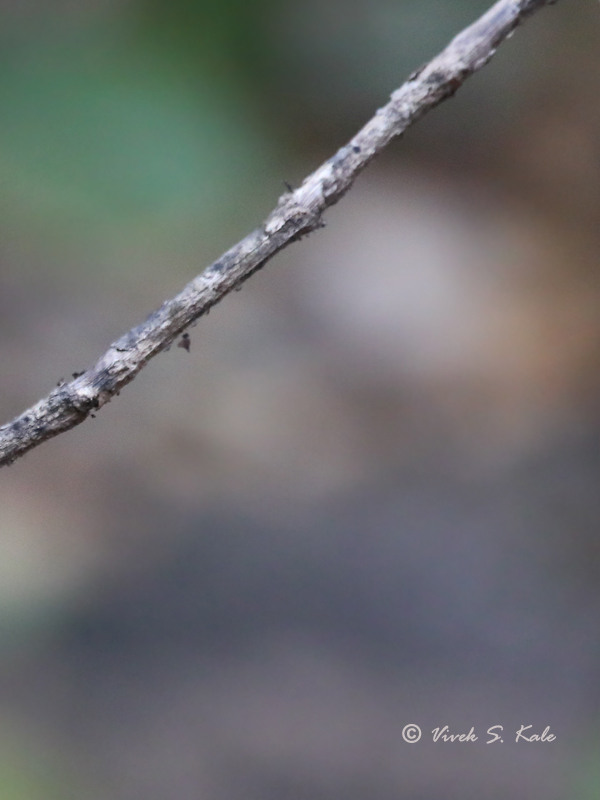  |
| 5. Verditer flycatcher, evergreen forest, Maharashtra, Western ghats, India |
| |
|
|
| |
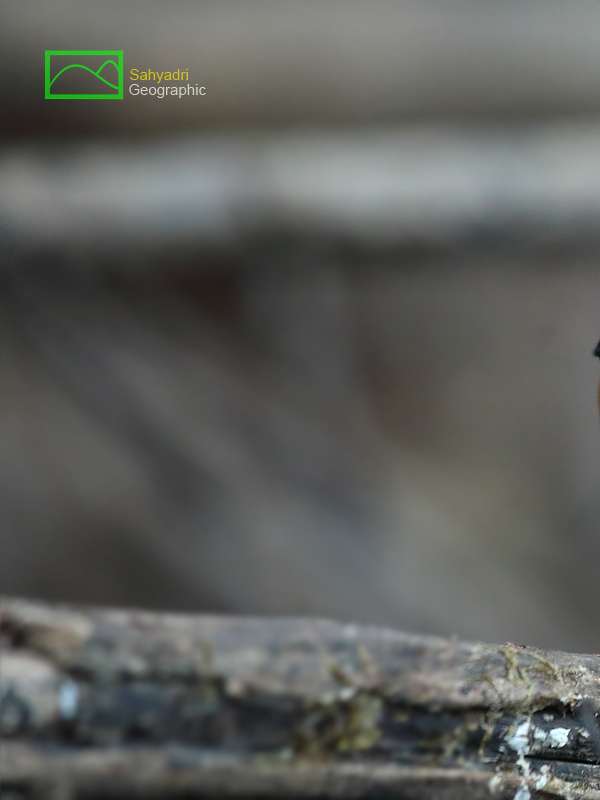 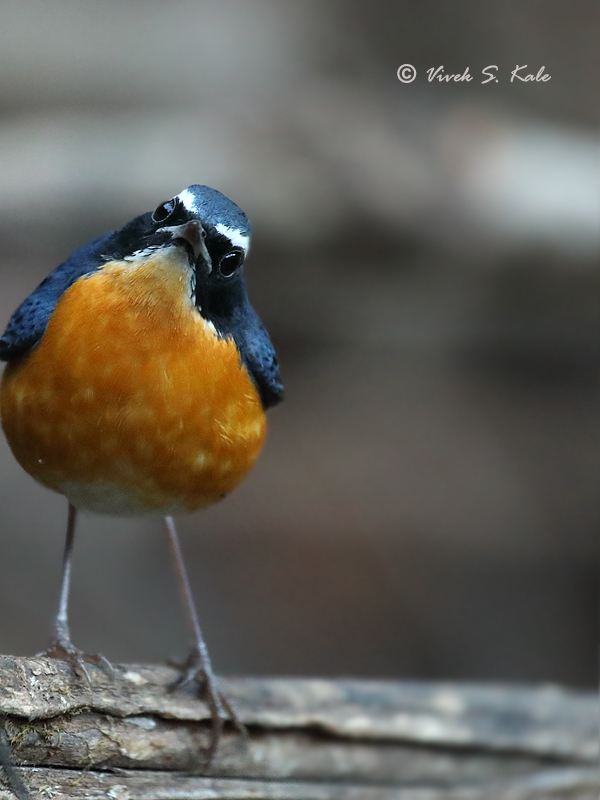  |
| 6. Indian blue robin male, evergreen forest, Maharashtra, Western ghats, India |
| |
|
|
इंडियन ब्लु रॉबिन हा एक लहान चिमणी पेक्षा थोडा मोठा पक्षी आहे. हा पक्षी हिमालयात व ब्रह्मदेश, चीन मध्ये विणीच्या हंगामात आढळतो. जंगलात जमिनीवर झाडांखालच्या पानगळीत हा पक्षी रहातो. पाठीकडे निळा तर पोटाकडे केशरी रंगाचा हा पक्षी दिसायला अत्यंत सुंदर दिसतो. मराठीत याला सर्वमान्य नाव नसले तरी आपण याला निळा चीरक असे म्हणु शकतो.
निळा चीरक आकाराने १३ ते १५ से.मी. लांब असतो. नर व मादी पक्षी रंगरुपाने वेगवेगळे दिसतात. याला इंग्रजीत सेक्शुअल डायमोर्फिजम असे म्हणतात.
नर पक्षी रंगरुपाने अत्यंत सुंदर असतो. नर पाठीकडे काळपट निळा असतो. तर छाती कडे तो केशरी रंगाचा असतो. त्याच्या डोळ्यावर सफेद आडवी भुवईसारखी लांब व रुंद पट्टी असते. इतरत्र डोळ्याच्या आजुबाजुसचा रंग काळपट निळा असतो. शेपटाखालचा भाग सफेद असतो. हनवटीला व काळ्या गालांखाली लहान सफेद लकेर असते. त्याचे पाय पांढरट गुलाबी असतात.
मादी पक्ष्याचा रंग हिरवट करडा भुरा असतो. पोटाकडे तीचा रंग सफेद असतो. पक्ष्याची पिल्ले एक दिड वर्षांपर्यंत मादी सारखी दिसतात. त्यांचे रंग जास्त गडद असतात.
|
|
Scientific name of Indian blue robin is Luscinia brunnea. The bird is also known as Indian blue chat. This is a small Himalayan bird from thrush family (Turdidae). It has blue and orange plumage. It is slightly larger than the common house sparrow. The bird seems to have no name in Marathi.
The bird is about 13 to 15 cm in size (length from its beak to tail). The sexual dimorphism can be seen in this bird species. Sexual dimorphism is the difference in appearance between males and females of the same species, such as in colour, shape, size, and structure.The male bird has blue upperparts. The underbody of male bird is orange rufous. The bird has long broad white supercilium. The lore of the male bird is bluish black. The eye strip is blusih black which coverts ear coverts up to neck. Point of chin and narrow line under the black cheeks is white. The under tail and lower belly are white. The legs and feet are pale pinkish white. Iris of the eyes is dark brown.
|
|
|
| |
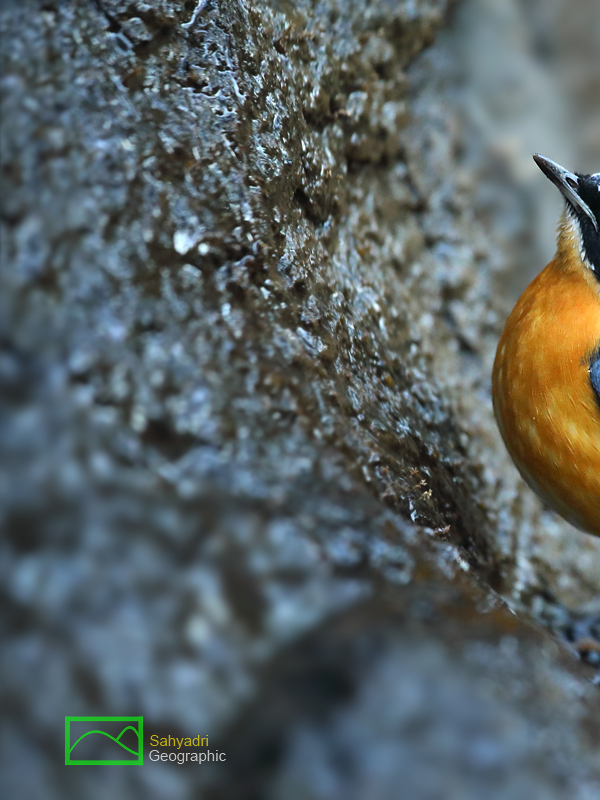 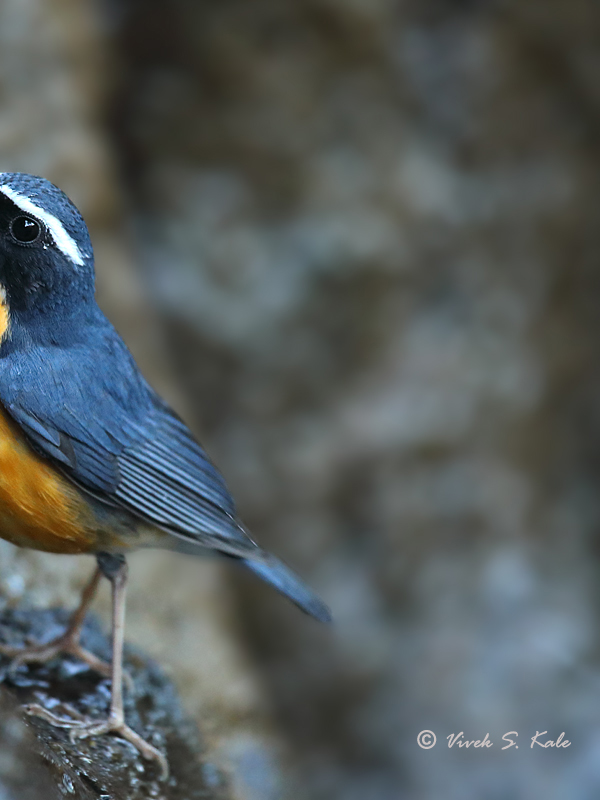
|
| |
| 7. Indian blue robin male, evergreen forest, Maharashtra, Western ghats, India |
| |
|
|
निळ्या चीरकाच्या दोन उपजाती आहेत. लुसिनिया ब्रुनिआ ब्रुनिआ आणी लुसिनिया ब्रुनिआ वीकहॅमी अशी त्यांची नावे आहेत. यातील लुसिनिया ब्रुनिआ ब्रुनिआ उपजातीचे पक्षी उन्हाळ्यात विणीसाठी उत्तर अफगाणीस्तान पासुन पुर्वोत्तर भारतातील हिमालयात, मध्य चीन मध्ये आढळतात. हिवाळ्यात लुसिनिया ब्रुनिआ ब्रुनिआ उपजातीचे पक्षी भारत व श्रीलंका च्या जंगलात आढळतात. लुसिनिया ब्रुनिआ वीकहॅमी उपजातीचे पक्षी मात्र स्थलांतर करत नाहीत. हे पक्षी मणिपुर व ब्रह्मदेशाच्या चीन प्रांतातील डोंगररांगामंध्ये आढळतात.
|
|
The adult female is olive-brown with whitish under-parts except for the Rufus breast.
The young male is like the female but has the back darker and much suffused with blue.There are two subspecies of Indian blue robin, Luscinia brunnea. The two subspecies are Larvivora brunnea brunnea and Larvivora brunnea wickhami. Out of these 2 subspecies, Larvivora brunnea brunnea is prominently recorded in India. Larvivora brunnea brunnea breeds in north east Afghanistan east through Himalaya to north eastern India and central china. The bird migrates in winter to India and Srilanka. The other subspecies Larvivora brunnea wickhami is recorded in Chin hills of Myanmar and is not migratory.
|
|
|
| |
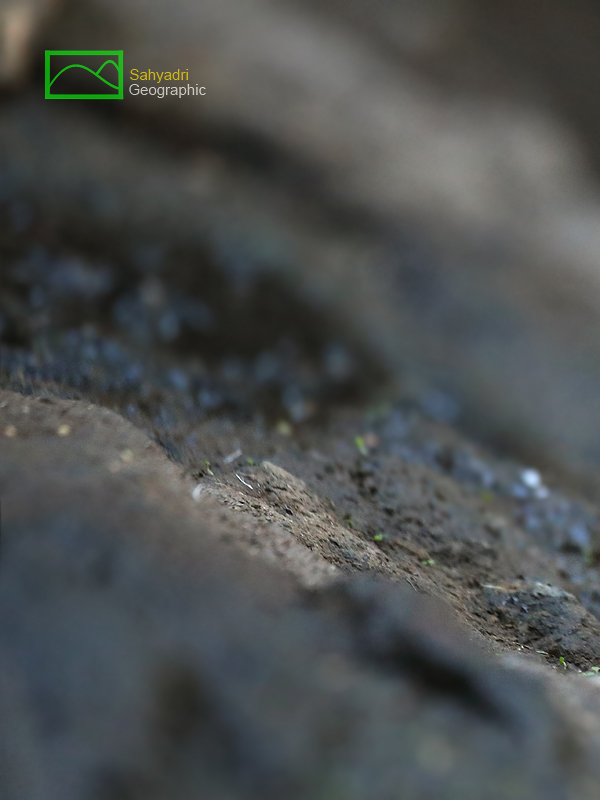 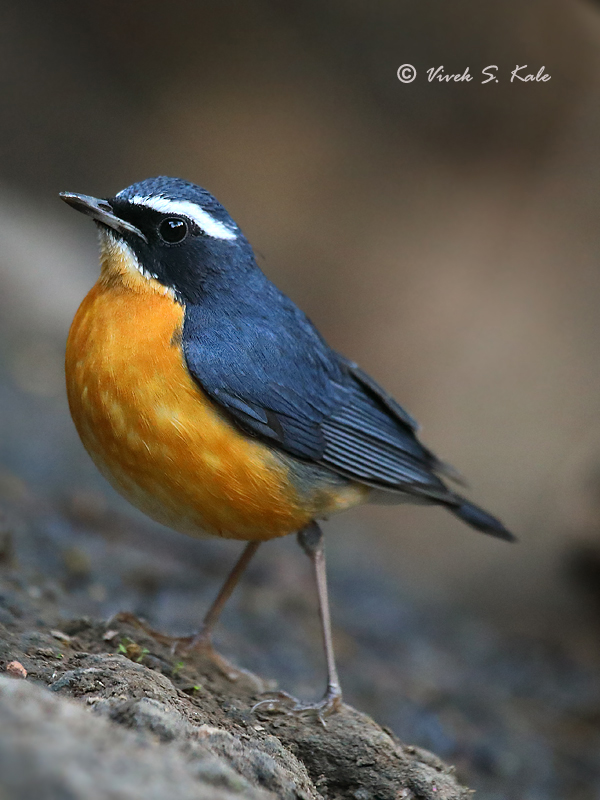
|
| |
| 8. Indian blue robin male, evergreen forest, Maharashtra, Western ghats, India |
| |
|
|
निळा चीरक किडे खातो. घनदाट जंगलात जमिनीवर पडलेल्या पालापाचोळ्यात हा पक्षी चालता चालता किडे पकडताना दिसतो. झाडांवर तो क्वचित जातो. असे चरताना तो क्वचित प्रसंगी उड़्या मारतो. शेपटाच्या पिसांचा फुलोरा करुन त्या हालचाली करतो. जमिनीवर पडलेली पाने उलटवुन तो त्या खालच्या किड़्यांना शोधतो. झऱ्यांच्या आजुबाजुस पाणथळ भागात तो हमखास आढळतो. मे ते जुलै या काळात तो हिमालयात व चीनमध्ये विणीसाठी जातो. तेथे तो जमिनीवर आपले घरटे बनवतो. हिवाळ्यात सह्याद्री, श्रीलंका, पुर्व घाटात जंगलात आढळतो. त्याची शीळ तो सुरवातीस संथ हळुहळु वाजवतो तर शेवटाला तो शीळ वाजवण्याची गती वाढवतो.
|
|
The Indian blue robin is insectivorous bird. These birds are found in dense evergreen forest undergrowth. It feeds mainly on the ground. It moves around in undergrowth in forested region.It uses its tail fanning for these small hops and manoeuvres on the ground. It turns the leaves on the forest floor to search the insects, particularly around the moist streams and under the trees with fruits fallen on the ground. It breeds from May to July in Himalaya. It nests on the ground. The female is believed to incubate but both sexes take part Indian blue robin sings and calla in their winter grounds. The song consists of sudden and sharp series of whistles ending in a rapid series of notes. They also utter a sharp and low clicking alarm note.
.
|
|
|
| |
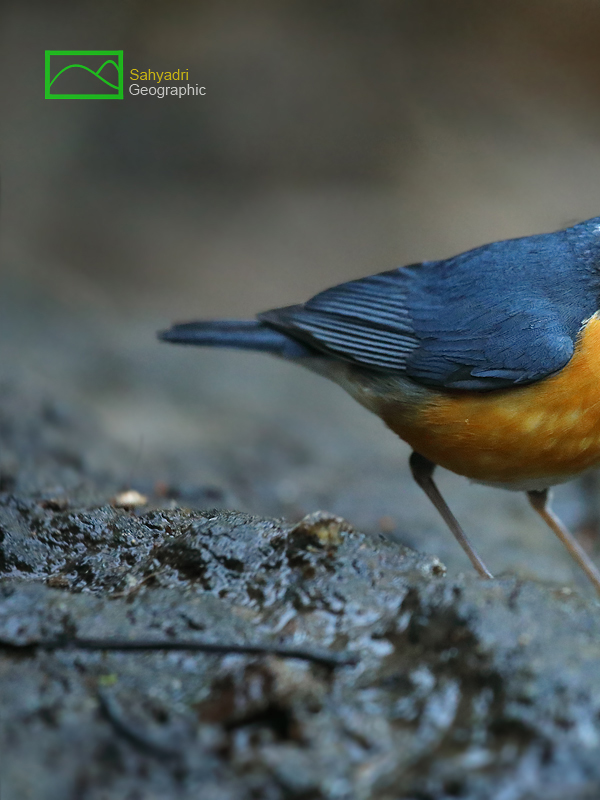 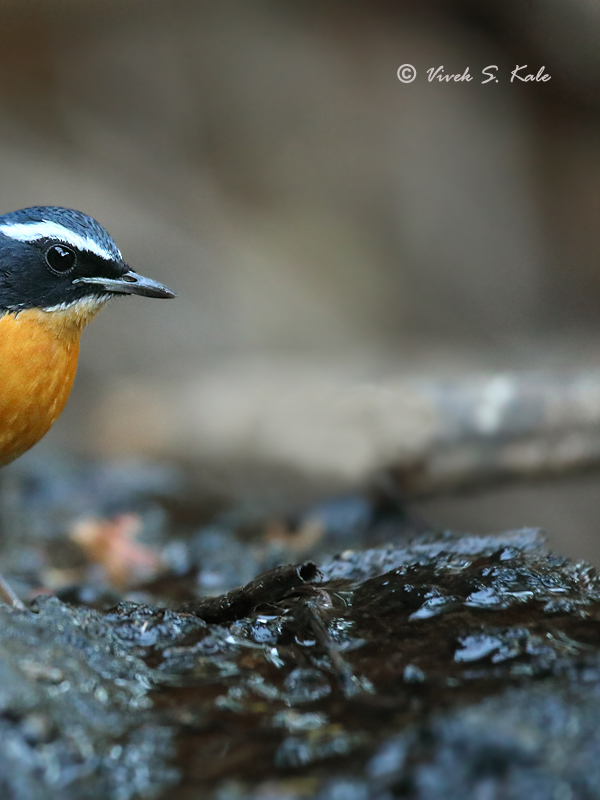
|
| |
| 9. Indian blue robin male, evergreen forest, Maharashtra, Western ghats, India |
| |
|
|
| |
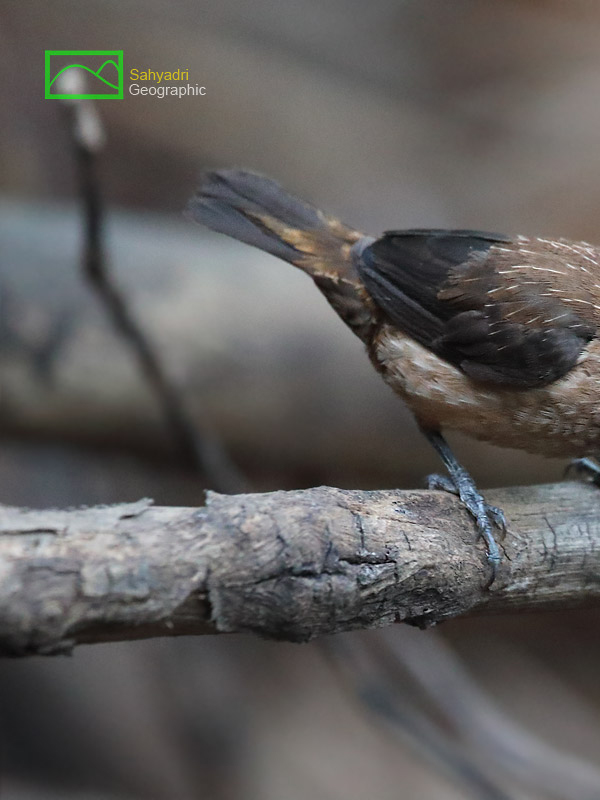 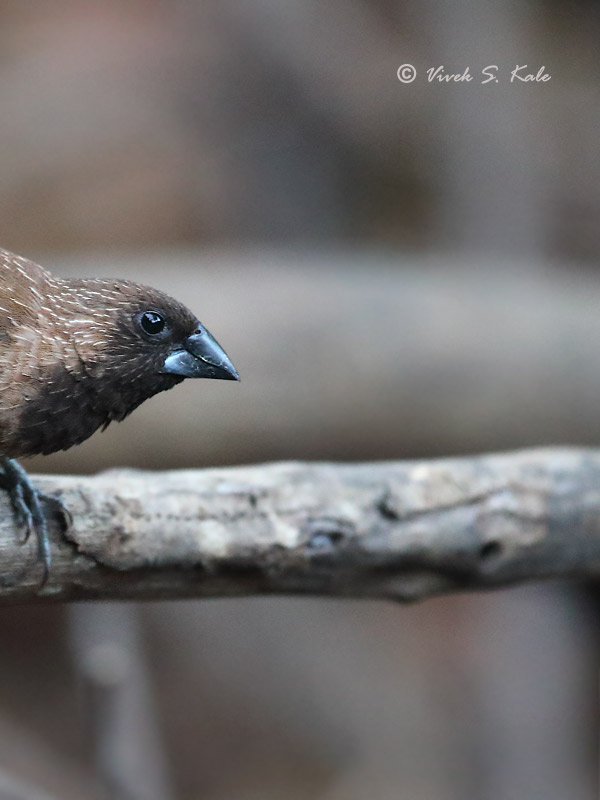
|
| |
| 10. Black throated Munia, evergreen forest, Maharashtra, Western ghats, India |
| |
|
|
ब्लॅक थ्रोटेड मुनिआ (कृष्ण कंठी मुनिआ) किंवा जेर्डोन मुनिआ हा एक लहान गवताच्या बिया खाणारा फिंच पक्षी आहे. हा पक्षी सह्याद्रीच्या सदाहरित जंगलात, पूर्व घाटातल्या जंगलात आणी श्रीलंकेत आढळतो.
या पक्ष्याच्या दोन उपजाती आहेत. किलार्ती उपजात श्रीलंकेत आढळते. जेर्डोनी उपजात सह्याद्री व पूर्व घाटात आढळते. जेर्डोनी उपजातीची मुनिआ, ची चोच मोठी आणी करड़्या रंगाची असते. या पक्ष्याचे डोके व कंठ काळ्या रंगाचे असतात. पाठीकडे याचा रंग काळा असतो. पोटाकडे याचा रंग फिकट तपकिरी असतो. त्याला गुलाबी छटा असते. जेर्डोनी उपजातीची मुनिआ भारतात अंतर्जन्य आहे. पश्चिम घाटात दक्षिणेकडे, ( गोवा. कर्नाटक, तमिळनाडु आणी केरळ) या भागातल्या जंगलात हा पक्षी आढळतो. उत्तरेकडे हा पक्षी महाराष्ट्रात तुरळक प्रमाणात सदाहरित जंगलात आढळतो. पूर्व घाटात आंध्रप्रदेश, ओरिसाच्या जंगलात हा पक्षी आढळतो.
|
|
The black-throated munia or Jerdon's mannikin (Lonchura kelaarti) is a small resident breeding bird in the western ghats hills of southwest India, and eastern ghats . This bird is endemic to this region. The black-throated munia feeds mainly on grass seeds. The black-throated munia is 12 cm in length with a long black tail.
There are mainly two sub species of this bird. The Lonchura kelaarti kelaarti sub species is seen in Srilanka. The Lonchura kelaarti jerdoni species is seen in South western ghats and eastern ghats. Earlier the species from eastern ghats Lonchura kelaarti vernayi was considered as separate sub species. The adult of the southwest Indian population,
The Lonchura kelaarti jerdoni, has a stubby grey bill, dark brown upperparts with pale streaks; a blackish brown face and breast; and pinkish brown underparts. The Lonchura kelaarti kelaarti of Sri Lanka has scaly pattern on the underparts and vent with the pale almost whitish shaft streaks contrasting on the darker back. The species Lonchura kelaarti jerdoni is endemic to India. Typically in western ghats, these birds are seen in forests of Goa, Karnataka, Tamilnadu and Kerala. Though the records of this bird from western ghats further north of Goa are very less, this species have been recorded from evregreen forests of South Maharashtra south of Bhimashankar. Such as this specimen seen in Bhimashankar wild life sanctuary in Maharashtra. The species are seen in eastern ghat forests of Andhra pradesh, Orisa and Telangana.
|
|
|
| |
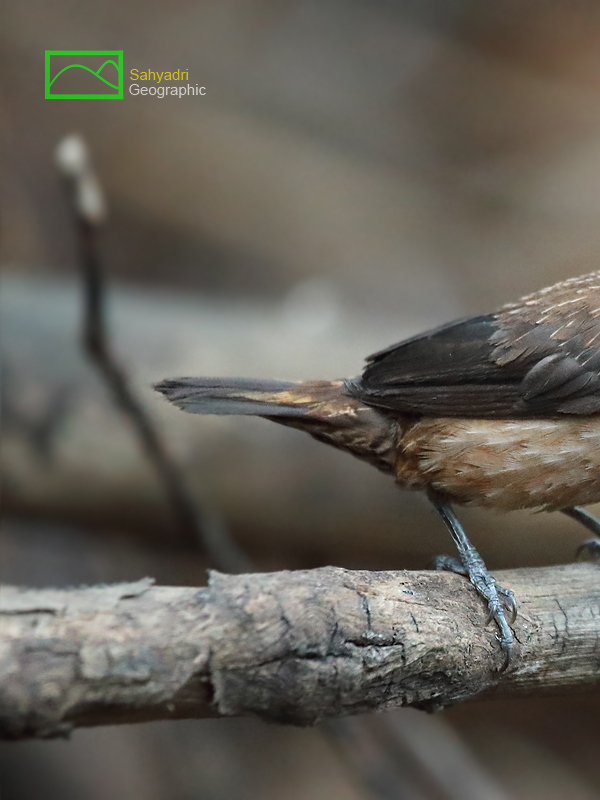 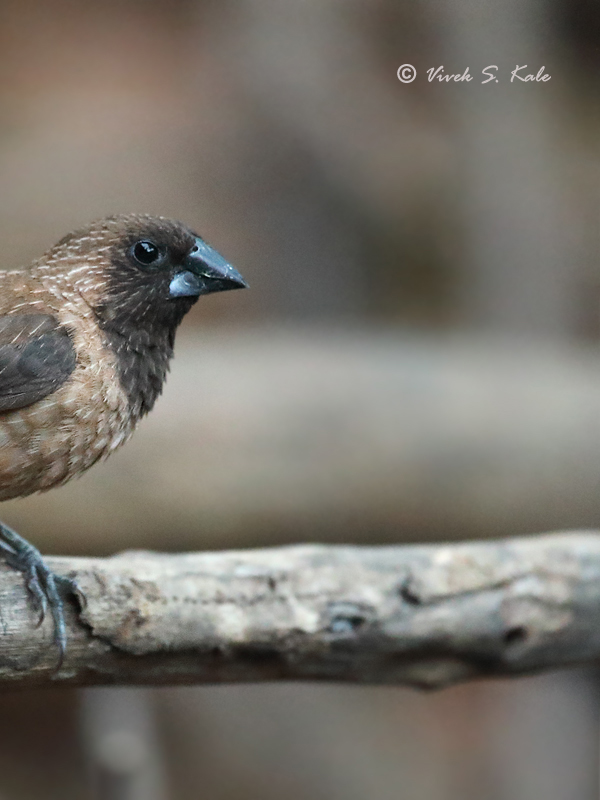
|
| |
| 11. Black throated Munia, evergreen forest, Maharashtra, Western ghats, India |
| |
|
|
| |
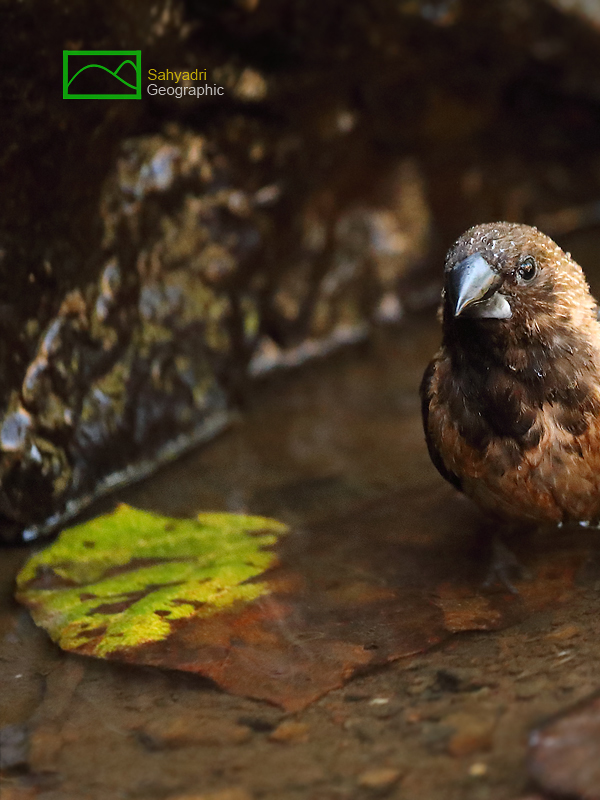 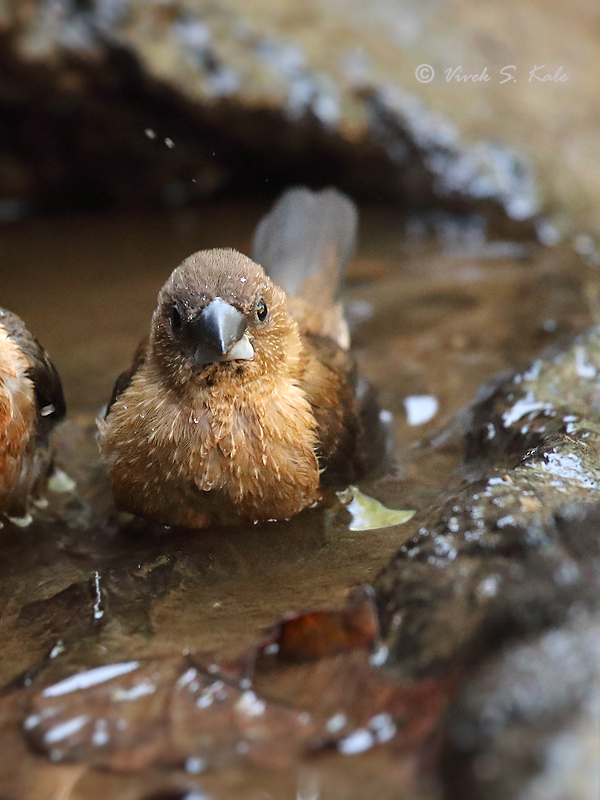
|
| |
| 12. Black throated Munia, evergreen forest, Maharashtra, Western ghats, India |
| |
|
|
| |
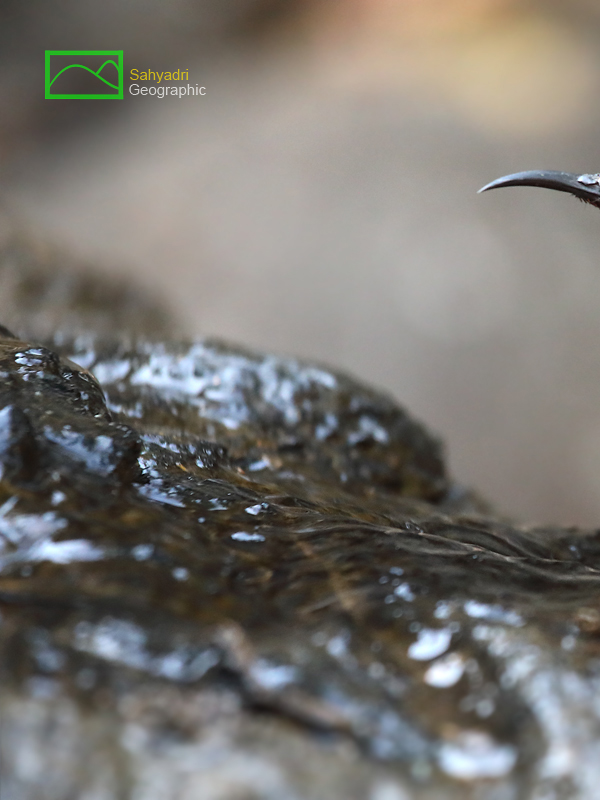 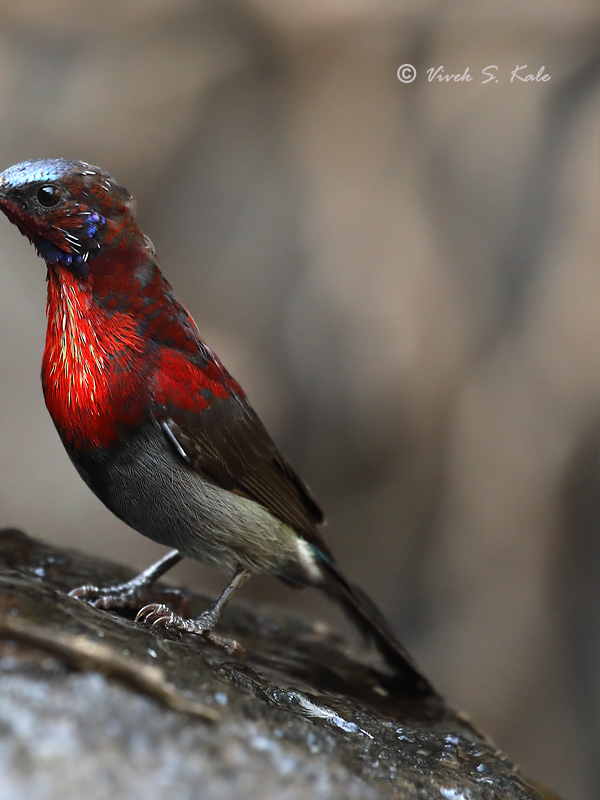
|
| |
| 13. Vigor’s sunbird, evergreen forest, Maharashtra, Western ghats, India |
| |
|
|
विगोर सनबर्ड हा अंदाजे १५ से.मी. लांबीचा मोठा शिंजिर (सूर्यपक्षी) भारतात अंतर्जन्य आहे. कोकणात, सह्याद्रीत, समुद्रसपाटीपासुन अंदाजे ९०० मीटर उंचीपर्यंत हा पक्षी आढ्ळतो. उत्तर सह्याद्रीत हा अंतर्जन्य आहे. हा पक्षी कारवार च्या उत्तरेस आढळतो. दक्षिणेस याचे प्रमाण तुरळक आहे. भारतात सूर्यपक्ष्याच्या (शिंजिर) एकूण १५ जाती आढळतात. यापैकी ६ जातींचे शिंजिर सह्याद्रीत आढळतात. जांभळा शिंजिर, जांभळ्या पाठीचा शिंजिर, लाल किरमिजी शिंजिर, लाल किरमिजी पाठीचा शिंजिर, विगर्स शिंजिर, लोटेन शिंजिर, लहान कोळीमार या सहा प्रजाती सह्याद्रीत आढळतात. या सर्व शिंजिर पक्ष्यांची चोच व जीभ लांब असते. विगोर्स शिंजिर भारतात आढळणाऱ्या शिंजिर पक्ष्यांमध्ये आकाराने मोठा शिंजिर आहे. नर पक्ष्याचे डोके, शेपटाकडची पिसे, शेपुट चमकदार हिरव्या रंगाची असतात. त्याच्या डोक्याचा बाजुचा भाग, मान, पाठ व खांदे लालसर किरमिजी रंगाचे असतात. गाल व गळ्याखाली जांभळी पट्टी असते. छातीकडचा भाग पिवळसर असतो, तर पोटाकडे याचा रंग करडा असतो. मादी पक्षी हिरव्या करड़्या रंगाची असते. आयरिश शास्त्रज्ञ एन. ए. विगोर यांच्या स्मरणार्थ या पख्श्याचे नाव विगोर सनबर्ड असे ठेवलेले आहे.
|
|
The Vigors's sunbird or western crimson sunbird (Aethopyga vigorsii) is a species of sunbird which is endemic to the Western Ghats of India. The bird is seen up to about 900 m altitude. This is one of the endemic bird which is mainly seen in north Western Ghats and Konkan (north of Karwar) as compared to southern western ghats.
There are about 15 species of birds from nectariniini in India. Out of these 15, 6 species are seen in western ghats. These five species include, purple rumped sunbird, purple sunbird, crimson backed sunbird, Vigor’s sunbird,Loten sunbird and small spiderhunter. As name suggests these sunbirds have a bill and tongue adapted to feed on nectar. They also eat small insects, spiders etc. The bill is very thin and long. They probe the corollas of flowers for nectar. The tongue is also very long and tubular and is used to draw the nectar from flowers.
The Vigors's sunbird or western crimson sunbird is one of the largest sunbirds in India.
The male bird’s crown, uppertail coverts, and tail is metallic green.Side of head, nape, mantle, back and shoulder are crimson. Rump is pale yellow. Malar stripe and cheek spot are metallic purple. Chin to upper breaset is streaked yellow. Rest of underparts is grey.
The female bird is olive, yellow with grey underparts, and yellow rump.
The species is distributed mainly in the northern Western Ghats but has been reported from the Nilgiris. It is named after Irish-born zoologist N.A. Vigors.
|
|
|
| |
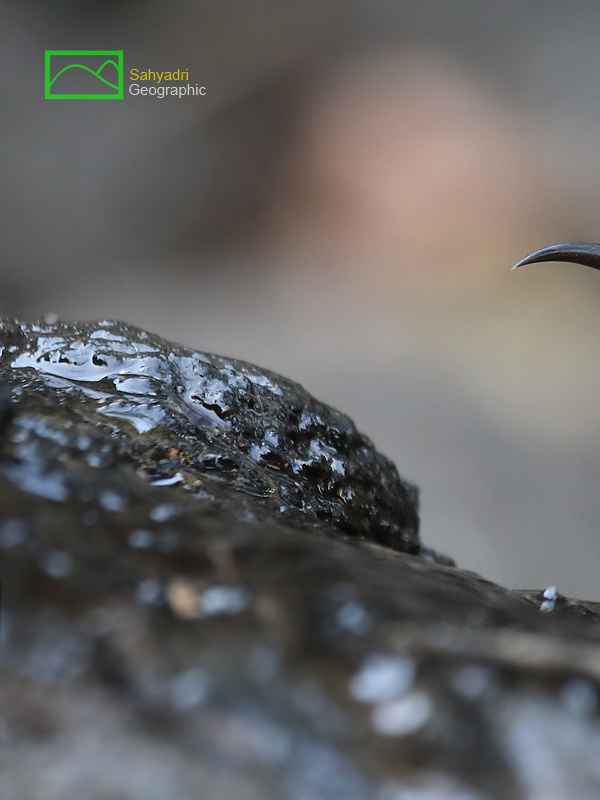 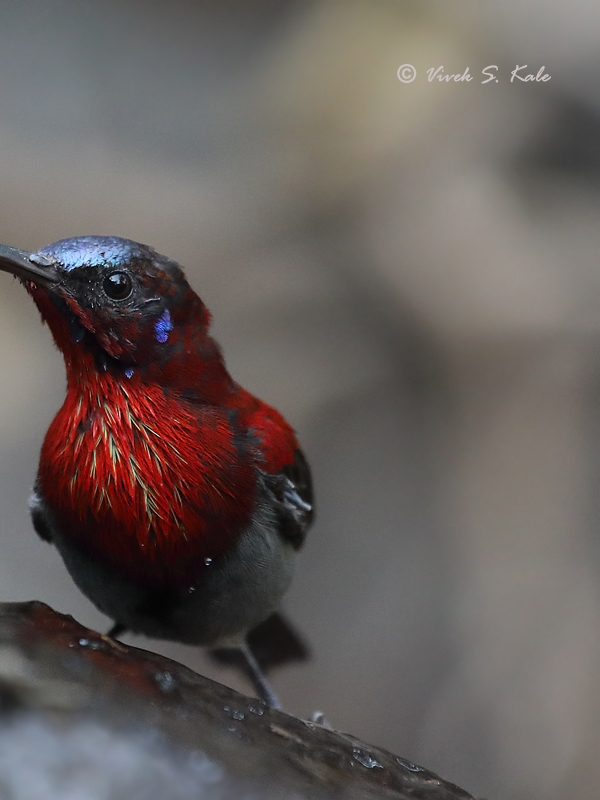
|
| |
| 14. Vigor’s sunbird, evergreen forest, Maharashtra, Western ghats, India |
| |
|
|
| |
 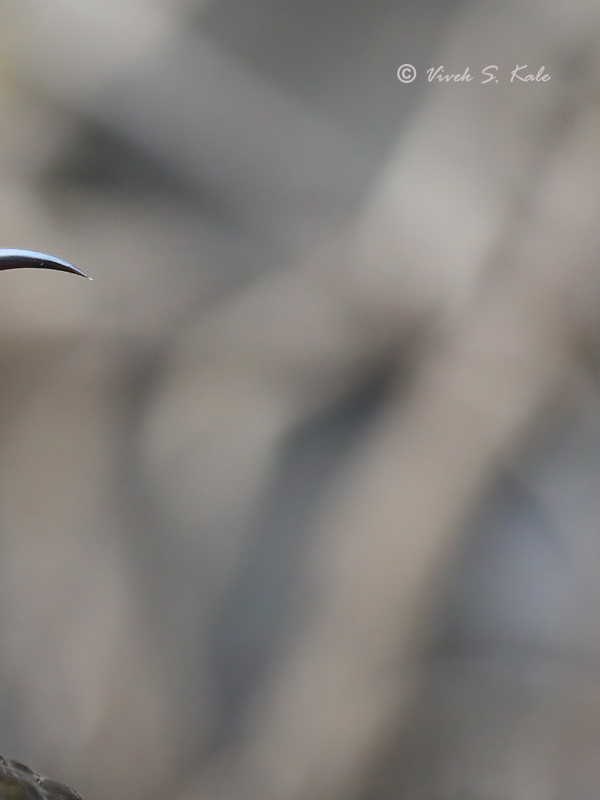
|
| |
| 15. Vigor’s sunbird, evergreen forest, Maharashtra, Western ghats, India |
| |
|
|
कॉमन रोजफिंच हा एक चिमणीपेक्षा थोडा मोठा पक्षी आहे. याला मराठीत सर्वमान्य नाव नाही. आपण याला गुलाबी चिमणी असे संबोधु शकतो. या जातीचा नर पक्षी रंगाने लाल गुलाबासारखा असतो. म्हणुन या पक्ष्याला रोजफिंच असे म्हणतात. शास्त्रीय भाषेत याला कार्पोडेकस एरिथ्रिनस असे म्हणतात. रोजफिंच कुळात १५ जातीचे पक्षी भारतात आढळतात. यातले बहुसंख्य पक्षी हिमालयात आढळतात. कॉमन रोजफिंच किंवा गुलाबी चिमणी उन्हाळ्यात विणीच्या हंगामात हिमालय, युरोप, सैबेरिया, मध्य आशिया मध्ये आढळतो. तर हिवाळ्यात हा पक्षी भारतात पठारी भागात आढळतो.
गुलाबी चिमणी अंदाजे १४ ते १५ से.मी. आकाराची असते. हा आकार म्हणजे पक्ष्याच्या चोची पासुन शेपटाच्या टोकापर्यंत्चे अंतर होय. या पक्ष्याची चोच चिमणीसारखी आखुड पण जाड शंखुसारखी असते. या आकारामुळे पक्ष्याला गवताच्या व इतर लहान बिया खाणे सोपे होते. या पक्ष्याच्या नर व मादीमध्ये रंगरुपात मोठा फरक असतो. अश्या फरकाला सेक्शुअल डायमोरफिजम असे म्हणतात.
|
|
Scientific name of common rosefinch is Carpodacuserythrinus. This is a small Himalayan bird from finch family which has red plumage just like the red rose. It is slightly larger than the common house sparrow. The bird seems to have no name in Marathi. Out of about 15 rosefinch species, common rosefinch is one of the most prominent and common rosefinch species is India.
The bird is about 14 to 15 cm in size (length from its beak to tail). The bird has short stocky conical beak. The beak is silvery grey. The shape of the beak is suitable for eating the seeds. The sexual dimorphism can be seen in this bird species. Sexual dimorphism is the difference in appearance between males and females of the same species, such as in colour, shape, size, and structure.
|
|
|
| |
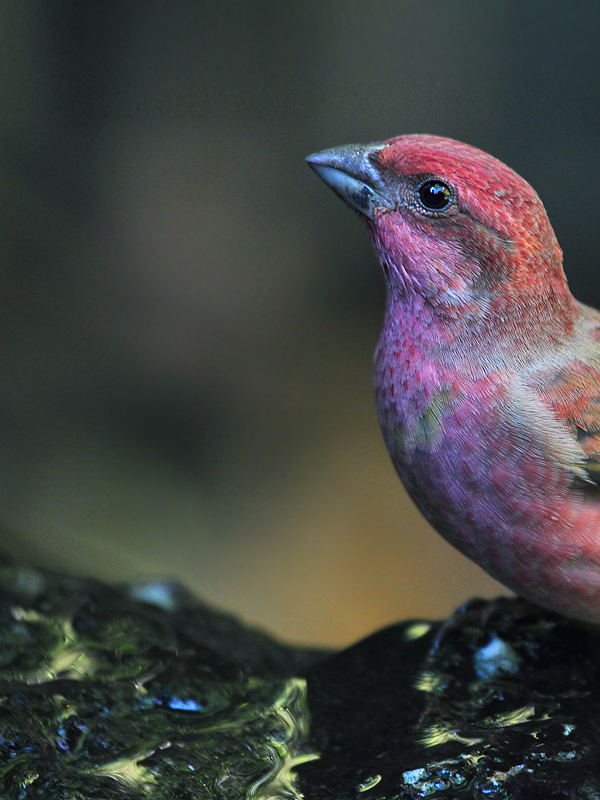 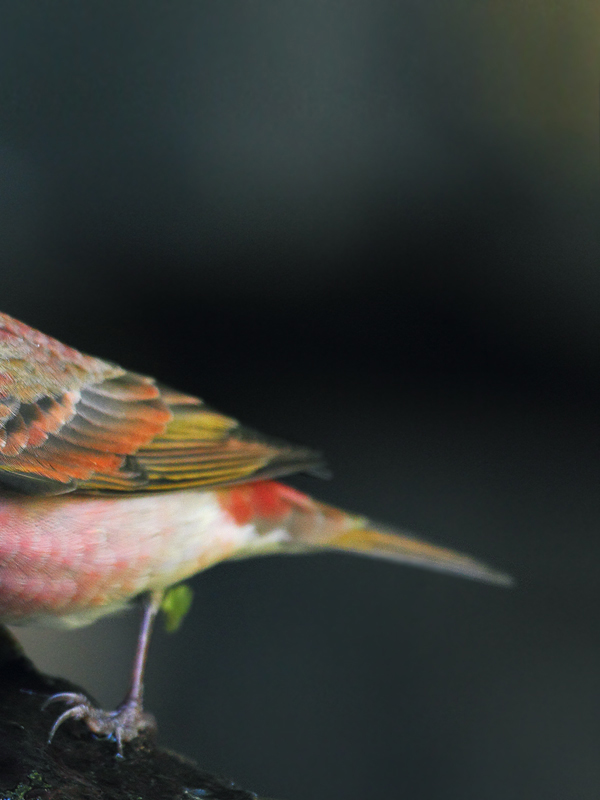
|
| |
| 16. Common rosefinch, evergreen forest, Maharashtra, Western ghats, India |
| |
|
|
नर पक्षी रंगाने गुलाबी लाल असतो. त्याचे डोके, छाती व पाठ गुलाबी असते. पक्ष्याचा पाठीकडच्या भागाला गुलाबी छटा असते. पोटाकडे पांढरट करड़्या रंगावर गुलाबी रेघा असतात. या पक्ष्याच्या पाच उपजाती आहेत. या उपजातींमध्ये रंग छटा थोड़्या वेगवेगळ्या असतात. नर पक्ष्याच्या डोळ्याभोवतीचा रंग थोडा तपकिरी असतो. त्याचे डोळे तपकिरी असतात. त्याचे पाय गुलाबी तपकिरी असतात.
|
|
The male bird has red head, red breast and red rump. The upperparts are streaked with red wash. The underbody is also streaked in red extended on flanks and under belly. The erythrinus subspecies has less red wash on its upperparts and underbelly. However in case of roseatus subspecies, the upperparts and underbelly is extensively red as compared to the erythrinus subspecies. The erythrinus species has brown mantle with white underpants with red streaks restricted to breast on underpants. The lore of the male bird is brown. The legs and feet are dusky brown. Iris of the eyes is dark brown.
|
|
|
| |
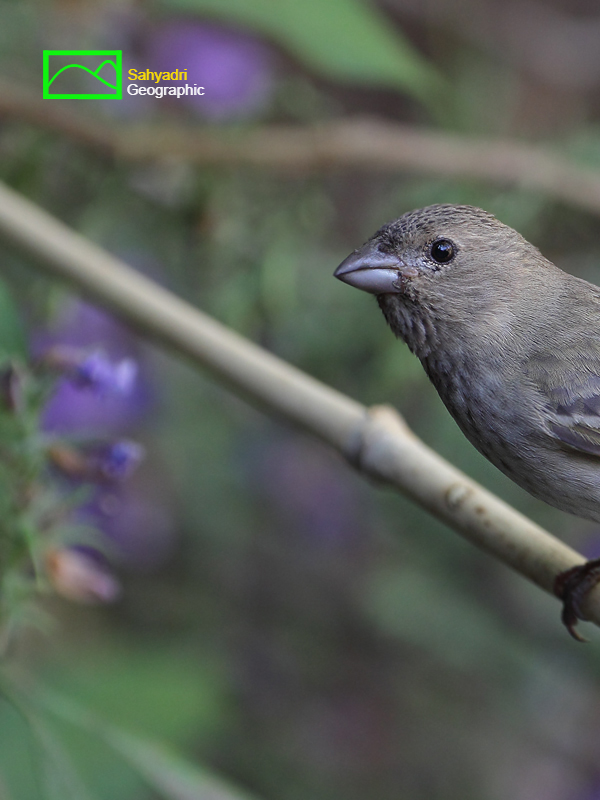 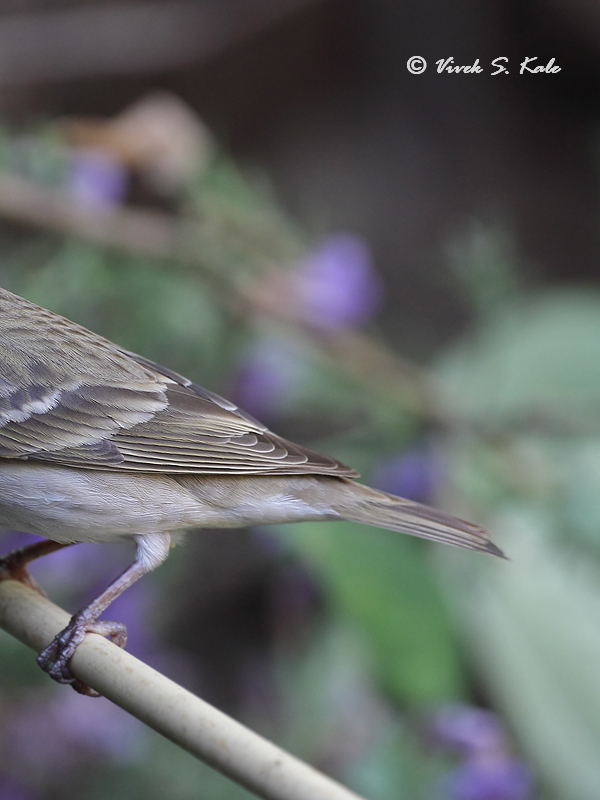
|
| |
| 17. Common rosefinch, evergreen forest, Maharashtra, Western ghats, India |
| |
|
|
मादी पक्षी रंगाने हिरवट करड़्या रंगाचा असतो. मादीच्या डोक्यावर, पोटाकडे हिरव्या रेघा असतात. पाच पोटजातींच्या मादींमध्ये फार लहान फरक आहे. नर व मादी पक्ष्यांची शेपटी दोन टोकाची असते. या पक्ष्याची पिल्ले एक दिड वर्षाची असे पर्यंत मादी सारखी दिसतात. त्यांच्या पोटावरच्या रेघा गडद असतात.
|
|
The female bird is olive grey in color. It has streaks on whitish underpants. It has buff median-covert wing bars. It has whitish greater-covert bars. The streaks seen in female erythrinus subspecies are faint as compared to roseatus subspecies. Both male and female have forked tail. So overall the erythrinus subspecies male and female are paler as compared to that seen in roseatus and ferghanensis subspecies. The juvenile birds are similar to female birds with prominent streaking.
|
|
|
| |
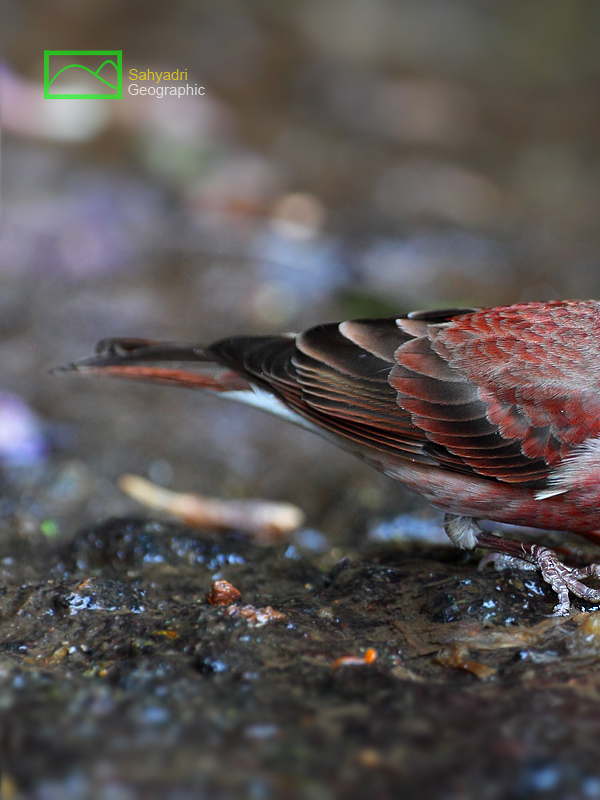 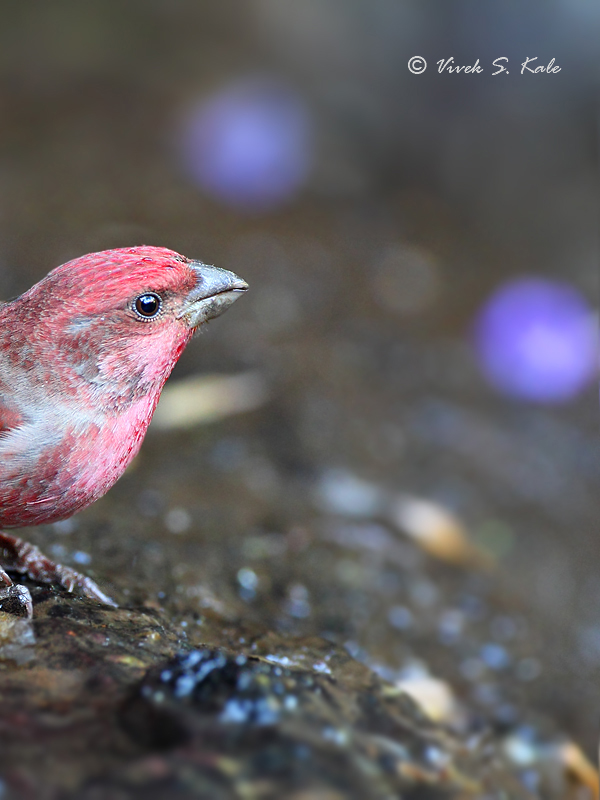
|
| |
| 18. Common rosefinch, evergreen forest, Maharashtra, Western ghats, India |
| |
|
|
या पक्ष्याच्या ५ उपजाती आहेत. एरिथ्रिनस, ग्रेबिनिट्स्की, कुबानेन्सिस, फरघानेन्सिस व रोजेअटिस अशी या पाच उपजातींची नावे आहेत. यातील चार उपजाती भारतात आढळतात. एरिथ्रिनस, कुबानेन्सिस, फरघानेन्सिस व रोजेअटिस या चार उपजाती भारतात आढळतात.
एरिथ्रिनस उपजातीचे पक्षी विणीसाठी उत्तर व पूर्व युरोप, पश्चिम सैबेरिया, युक्रेन, मंगोलिया मध्ये जातात. हिवाळ्यात ते भारत, थायलंड ला स्थलांतर करतात. कुबानेन्सिस उपजातीचे पक्षी विणीसाठी तुर्कस्तान, कोकेशियस, इराण, तुर्कमेनिस्तान येथे जातात. हिवाळ्यात ते भारतात स्थलांतर करतात. फरघानेन्सिस उपजातीचे पक्षी विणीसाठी कझाकस्तान, किरगिझस्तान, पश्चिम चीन, अफगाणीस्तान, वायव्य हिमालय येथे जातात. हिवाळ्यात ते वायव्य भारतात स्थलांतर करतात. रोजेअटिस उपजातीचे पक्षी विणीसाठी मध्य व ईशान्य हिमालय, तिबेट, ब्रह्मदेश येथे जातात. हिवाळ्यात ते वायव्य रत, बह्मदेश, थायलंड, लाओस, व्हिएतनाम आणी आग्नेय चीन मध्ये स्थलांतर करतात.
|
|
There are five subspecies of common rosefinch, Carpodacus erythrinus. The five subspecies are Carpodacus erythrinus erythrinus ,Carpodacus erythrinus grebnitskii , Carpodacus erythrinus kubanensis , Carpodacus erythrinus ferghanensis and Carpodacus erythrinus roseatus. Out of these 5 subspecies, four subspecies are recorded in India. The subspecies seen in India are Carpodacuse rythrinus erythrinus ,Carpodacus erythrinus ferghanensis, Carpodacus erythrinus kubanensis and Carpodacus erythrinus roseatus.
Carpodacus erythrinus erythrinus breeds North and east Europe, West Siberia North west Mongolia and Croatia, Romania, Ukraine, Kazakhstan in summer. It migrates to the plains of Indian subcontinent and north west Thailand in winter. Carpodacus erythrinus kubanensis breeds in Turkey, Caucasus, north Iran and Turkmenistan in summer and migrates to the plains of Indian subcontinent in winter. Carpodacus erythrinus ferghanensis breeds in mountains of Kazakhstan, Kyrgyzstan, West China, Afghanistan, North West Himalayas east to Kashmir) in summer and migrates to north west India in winter. Carpodacus erythrinus roseatus breeds in central and east Himalayas from Ladakh to North East India, North Myanmar, Tibetan plateau. It winters in India, Myanmar, Thailand, Laos,Vietnam and South east China.
|
|
|
| |
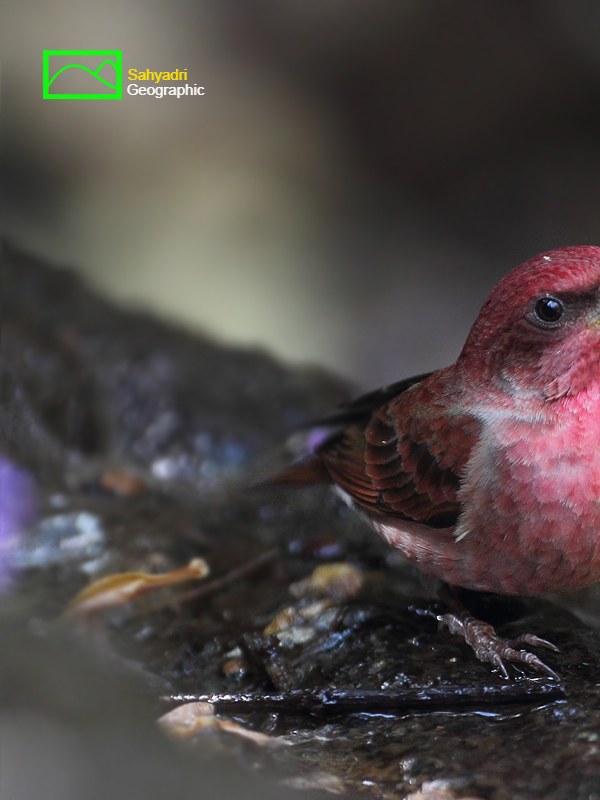 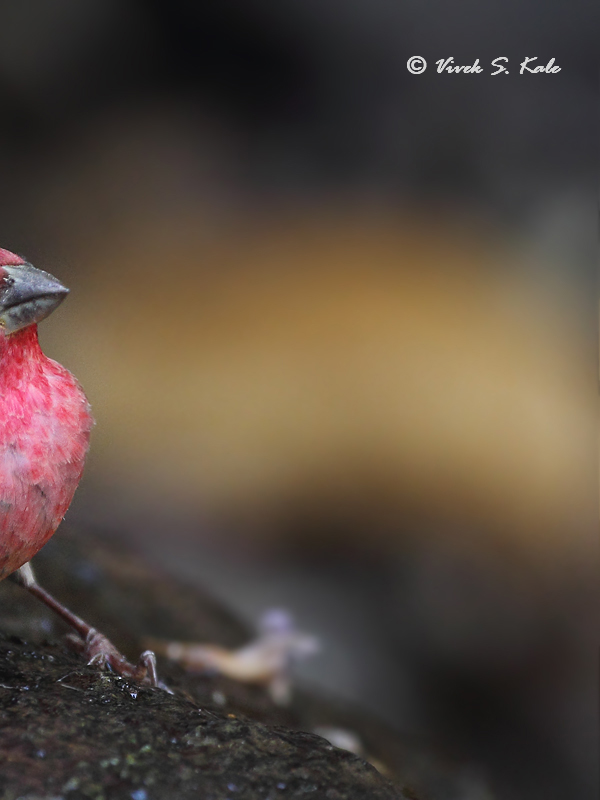
|
| |
| 19. Common rosefinch, evergreen forest, Maharashtra, Western ghats, India |
| |
|
|
गुलाबी चिमणी हिवाळ्यात मध्य व दक्षिण भारतात आढळते. युरोप, सैबेरिया, मध्या आशिया मधुन आलेल्या चार उपजातींचे पक्ष्यांचे थवे भारतात हिवाळ्यात पसरतात. हे पक्षी गवातचे बी, फुलांमधले मध, पराग, व लहान फळे खातात. मे ते सप्टेंबर या काळात ते उत्तरेकडे विणी साठी जातात. हे पक्षी लहान झाडांवर गवतापासुन घरटे बनवतात.
|
|
The birds are seen in flocks in winter during the migration. The birds feed on nectar, small fruits and seeds. The bird breeds in summer from June to September. It builds its nest in bush using grass.
|
|
|
| |
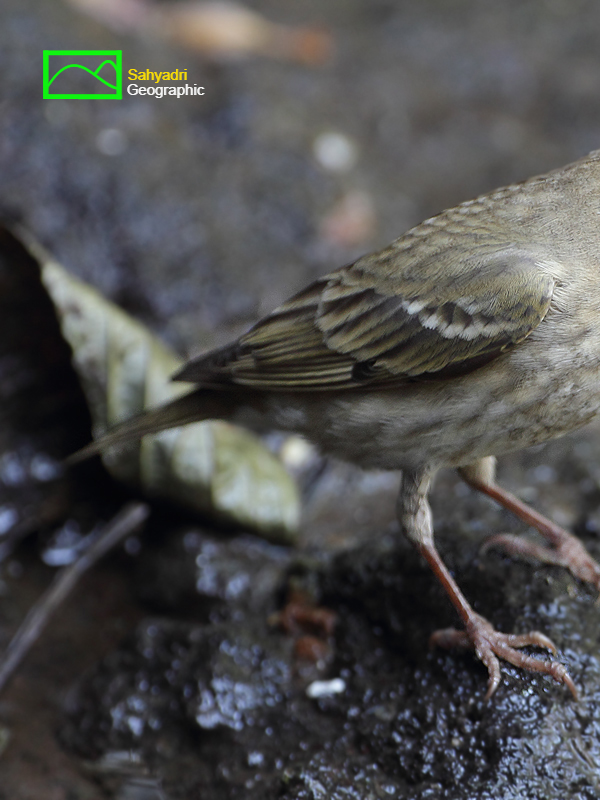 
|
| |
| 20. Common rosefinch, evergreen forest, Maharashtra, Western ghats, India |
| |
|
|
| |
|













































